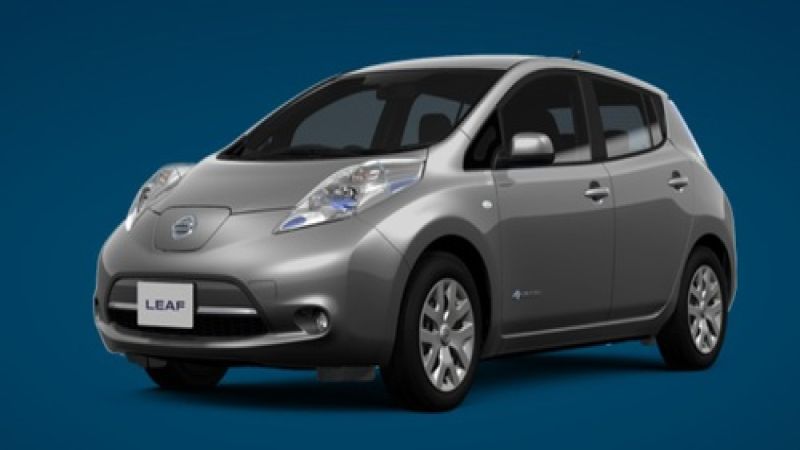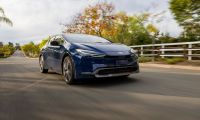Back in August, rumors began circulating about changes to the Nissan Leaf for the 2013 model year. On Monday this week, Nissan released details of the Japanese version of the 2013 Nissan Leaf. The specs for the Japanese version may or may not apply to the American 2013 Nissan Leaf, because that car is due to be built in Tennessee in a factory which apparently has not yet begun production. The good news is that the Japanese 2013 Leaf offers more car at a lower price, and assuming the American model will do likewise it could mean good thing for Leaf sales.
Nissan describes the Leaf as the number one selling electric car in the world. This may come as a shocker to Americans who see Leaf sales portrayed as "dismal" but globally Nissan has sold over 43,000 Leaf's in about over 2 years. While it's a drop in the bucket compared to gasoline car sales, it means a large percentage increase of electric vehicle presence in the world over what existed 2-3 years ago.
The Japanese Leaf 2013 lineup now has three grades: G, X and the new, lower-priced, S.
Enhancements for the 2013 model year include: Available genuine leather seats; BOSE Energy Efficient Series sound system; Around View Monitor which assists parking at roadsides; Driving range of 228km at a full charge (JC08 mode); Enhanced regenerative braking performance; A power-saving heating system.
Improved cargo area: Luggage space has increased from 330 liters to 370 liters, made possible by relocating the on-board charger to the front of the car.
Improved efficiency: The heating system includes a heat-pump cabin heater, heated seat for all seats, heated steering wheel and heat shield ceiling. All of these work together to heat the passenger cabin at less energy cost, leaving more energy for driving range.
The regenerative braking enhancements change the regenerative braking algorithm, to enable more efficient power generation when the brakes are operated. This means the 2013 Leaf will have an effectively longer driving range due to more power recovery during braking.
Improved Range: The range estimate of 228 kilometers (141 miles) has to be taken with a huge grain of salt, because it is estimated using the Japanese protocol. The U.S. EPA has a different protocol that results in a more conservative driving range estimate. What's important is the percentage increase, from a 124 mile JC08 range for the 2012 Japanese Leaf, to a 141 mile JC08 range, representing a 14% jump in electric driving range. The American 2012 Leaf is spec'd by the EPA with a 73 mile electric driving range, and if the same percentage range increase holds for the American 2013 Leaf the electric driving range will be 83 miles. These numbers are in line with previous rumors about the 2013 Leaf.
A longer electric driving range, coupled with the 6.6 kilowatt charger option that we know will be available for the 2013 Leaf, will make the Leaf a much more interesting electric car than it is today. These two attributes will work together to increase the effectively usable driving radius, and change the Leaf's role from primarily an around-town car to one that can relatively easily handle medium distance trips.
Integrated power electronics modules with motor: The battery pack is unchanged for the 2013 Leaf, so how did they achieve a longer range? The more efficient cabin heater helps, as does the improved regenerative braking system. Nissan's engineers have made better integration of the high voltage unit, including an electric motor, inverter and DC/DC converter, resulting in a 30 percent volume reduction and a 10 percent mass reduction. They also designed a new electric motor that more responsive and exhilarating acceleration. In other words, Nissan optimized several systems on the 2013 Leaf, reduced its weight, adding up to a more efficient car that can squeeze more miles out of the kilowatt-hours stored on-board.
Lower price: The prices announced for the Japanese 2013 Leaf aren't directly transferable to the U.S. however, again, what may be important is the percentage difference between the models. The Japanese base prices are: G – 4,133,850 ¥ (US Model SL); X – 3,757,950 ¥ (US Model SV); S – 3,349,500 ¥. This means the new S model Leaf is 12% cheaper than the previous entry model Leaf. If this holds for the U.S. model, the entry level 2013 Leaf price will be $31,500 while the MSRP of the 2012 Leaf SV is $35,200. With tax rebates the price drops to $24,000, and $21,500 in California, thanks to the CVRP program.
If those numbers hold true in the U.S. it would put the Leaf in the price range of the Toyota Prius models. The regular Prius has a base MSRP of $24,200, and the Prius Plug-in has an MSRP of $32,000.
Improved ergonomics: There are also a long list of styling upgrades and improvements, including: New wheel and wheel cover choices; LED headlights; Black interior option; the aforementioned leather seats option; a Highly concentrated Plasma Cluster Ion generator to eliminates odors and kill germs; Hill Start Assist which enables a driver to start the LEAF on a slope without worrying about rolling backward.
One of the most appreciated features will be changes to the information display. Battery capacity can be displayed as a percentage, rather than the inaccurate bar graph currently used. Addition of “Stop-off charging spot guidance” function, “Power-saving route guidance” function and “Battery capacity at a destination forecast” function which can allay potential range anxiety. New ways to search for and locate charging spots easily and quickly. Adoption of “Charging spot availability information provision” function, “Quick charger location display” function and “Unavailable charging spot display” function.












Comments
This confirms again how
Permalink
This confirms again how second generations are always better, more efficient and cheaper than the first ones. I'm happy to see this rumor shaping up to be true.
I ofter read that battery
Permalink
In reply to This confirms again how by Nicolas Zart
I ofter read that battery capacity improves at over 5% per year; and the price and weight per kWh decreases.
Therefore I find it strange that they are using the same pack.
I can only assume, and hope, that part of the cost and weight reduction is due to not increasing energy storage at the same price.
I think most of the work done
Permalink
In reply to I ofter read that battery by David Stone (not verified)
I think most of the work done by manufacturers is in enhancing energy management, i.e. making EV more efficient by using less to go more, often enough on the same battery pack.
what is the difference
Permalink
what is the difference between X and G models